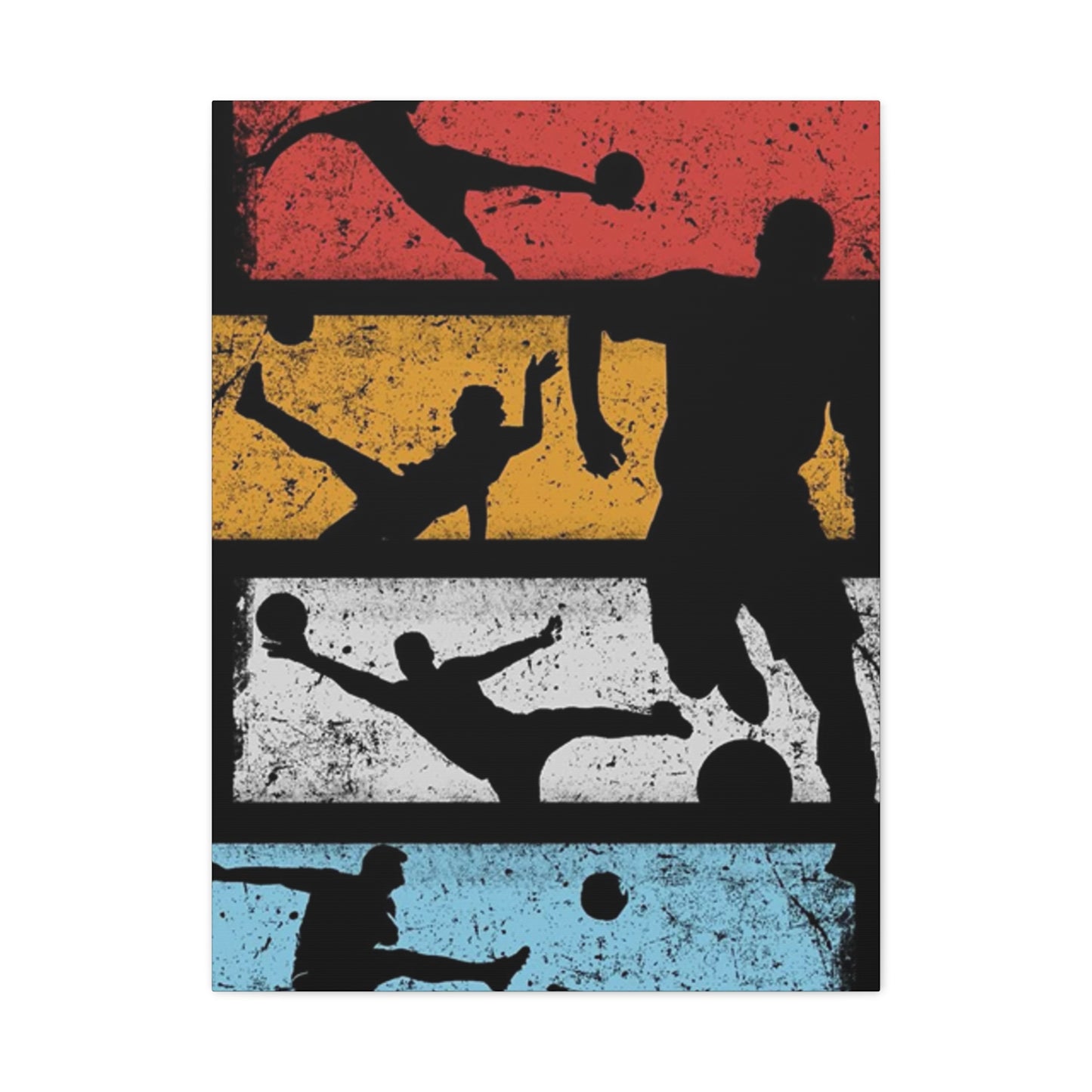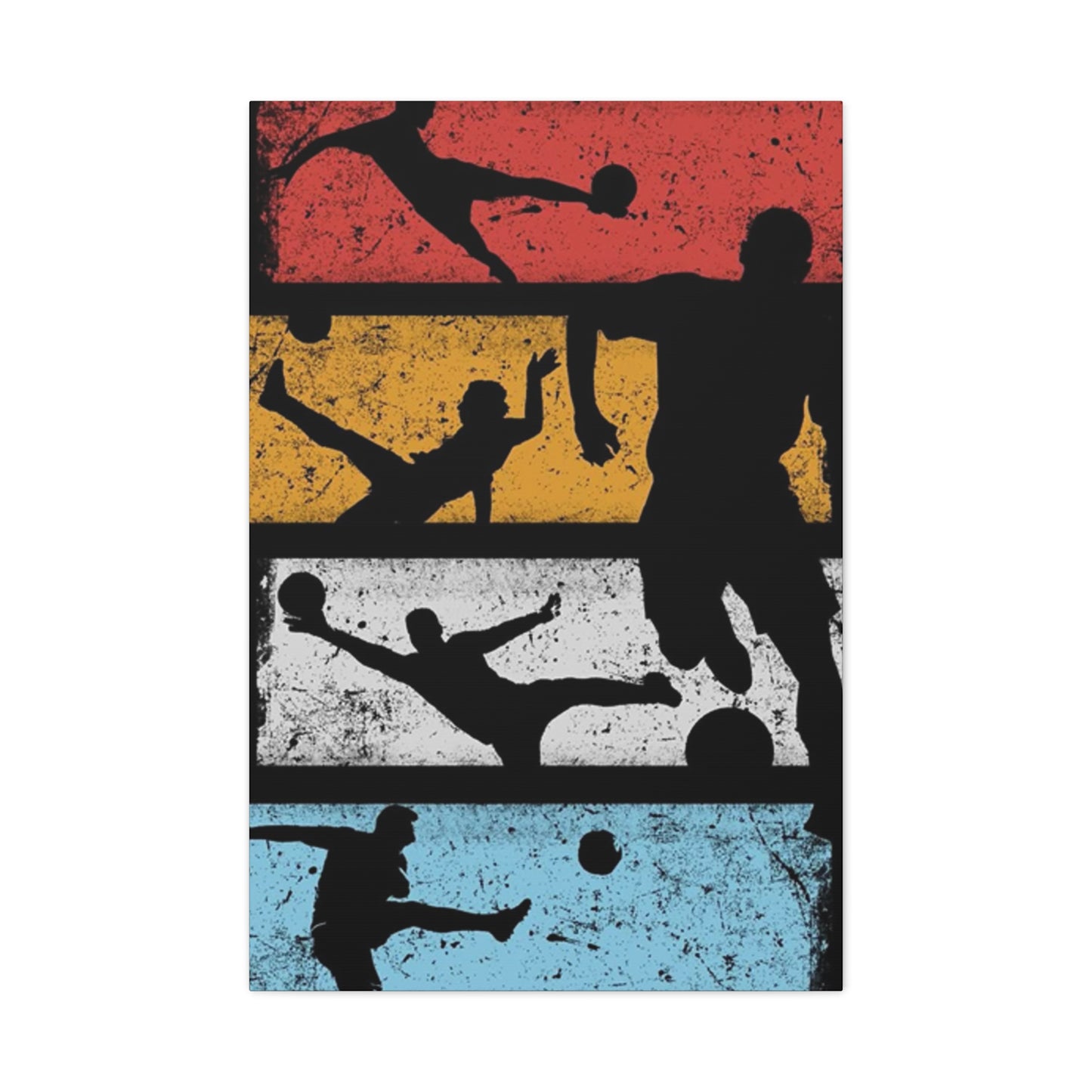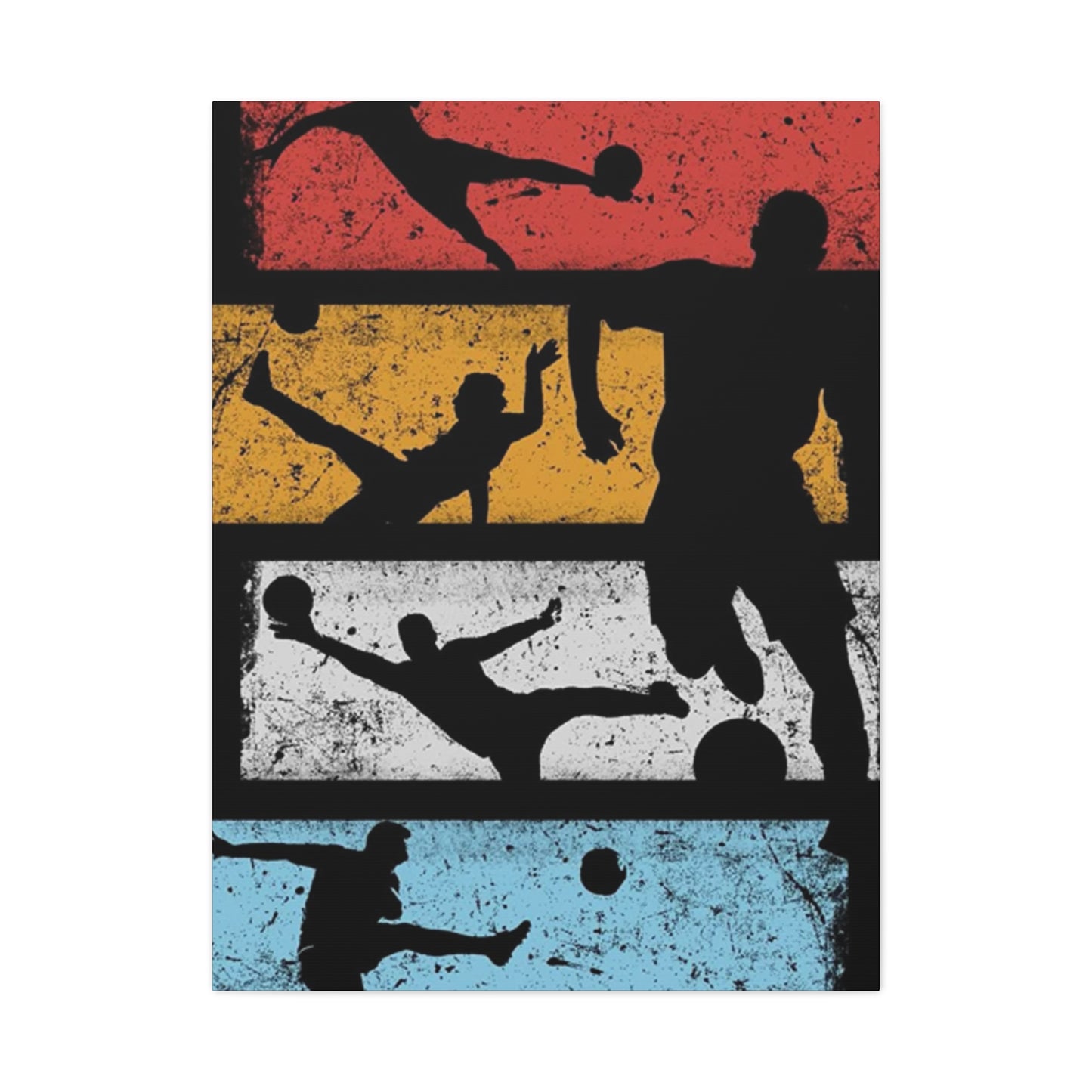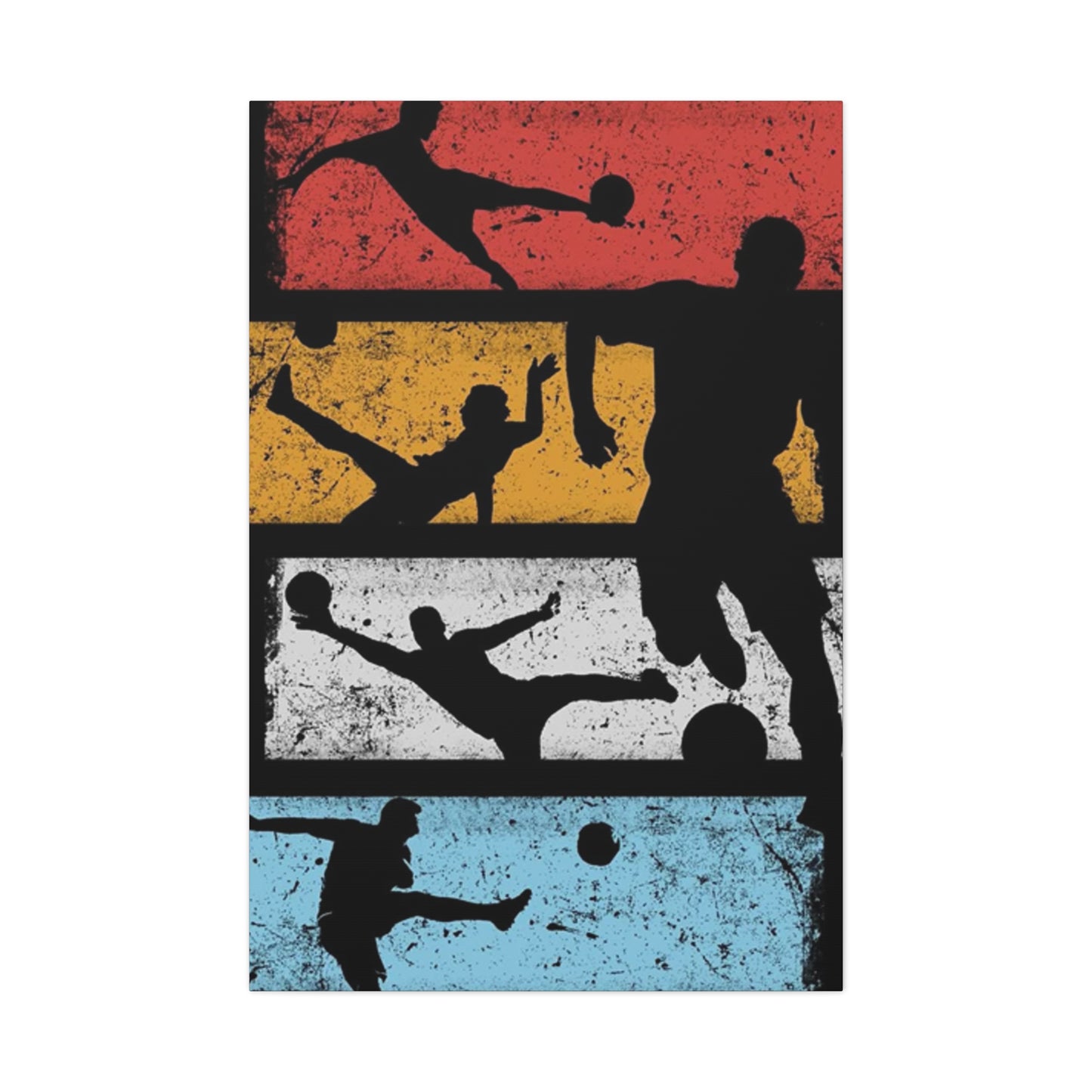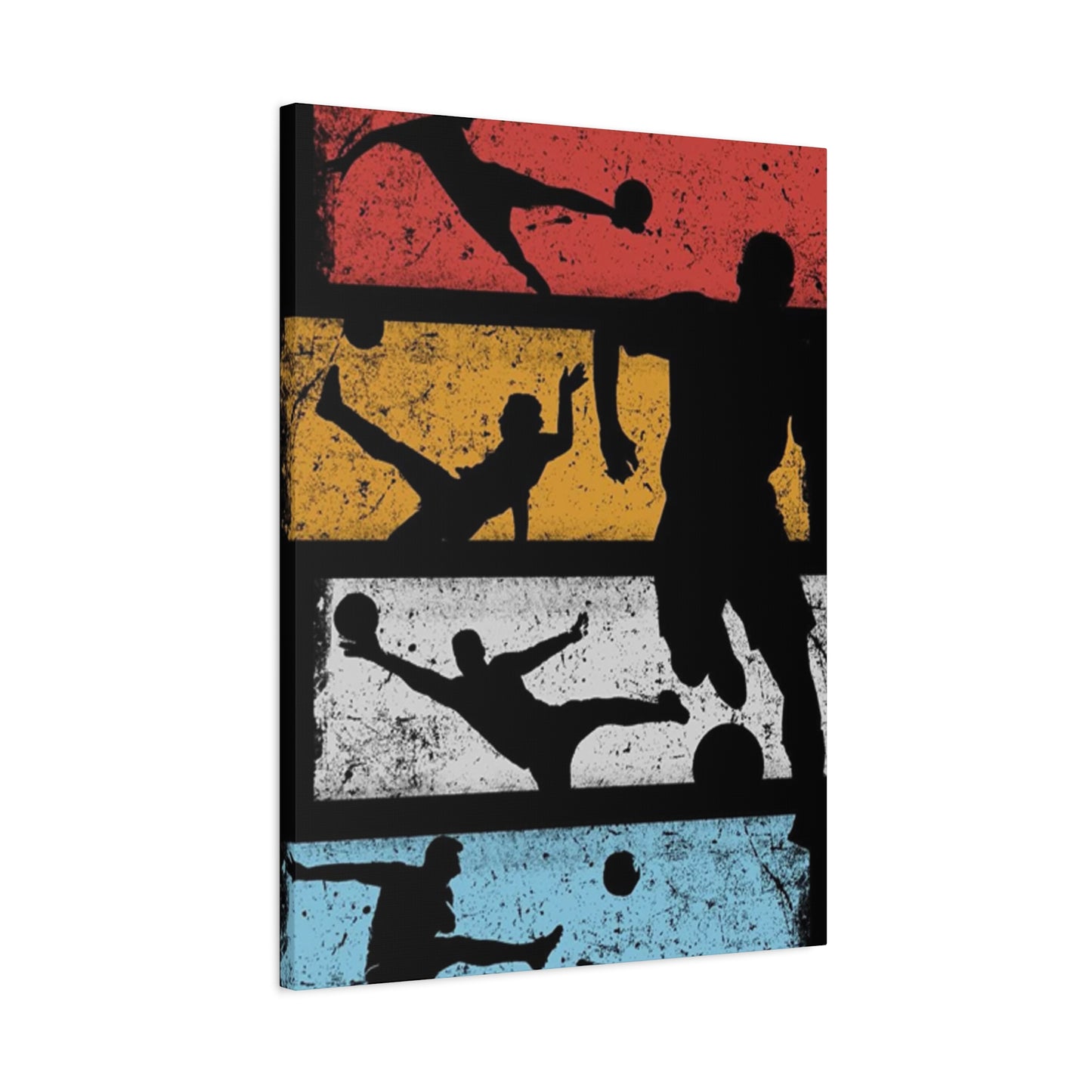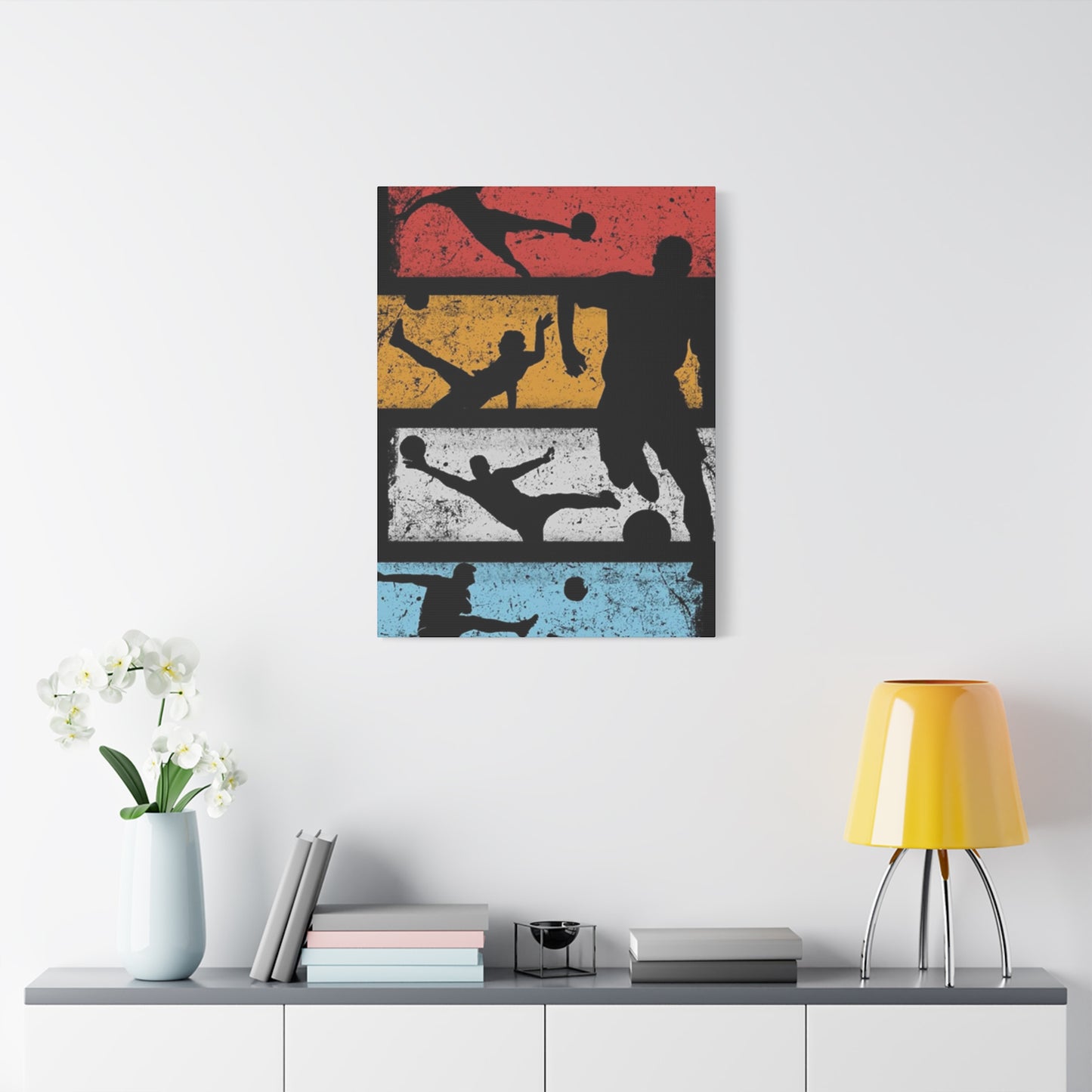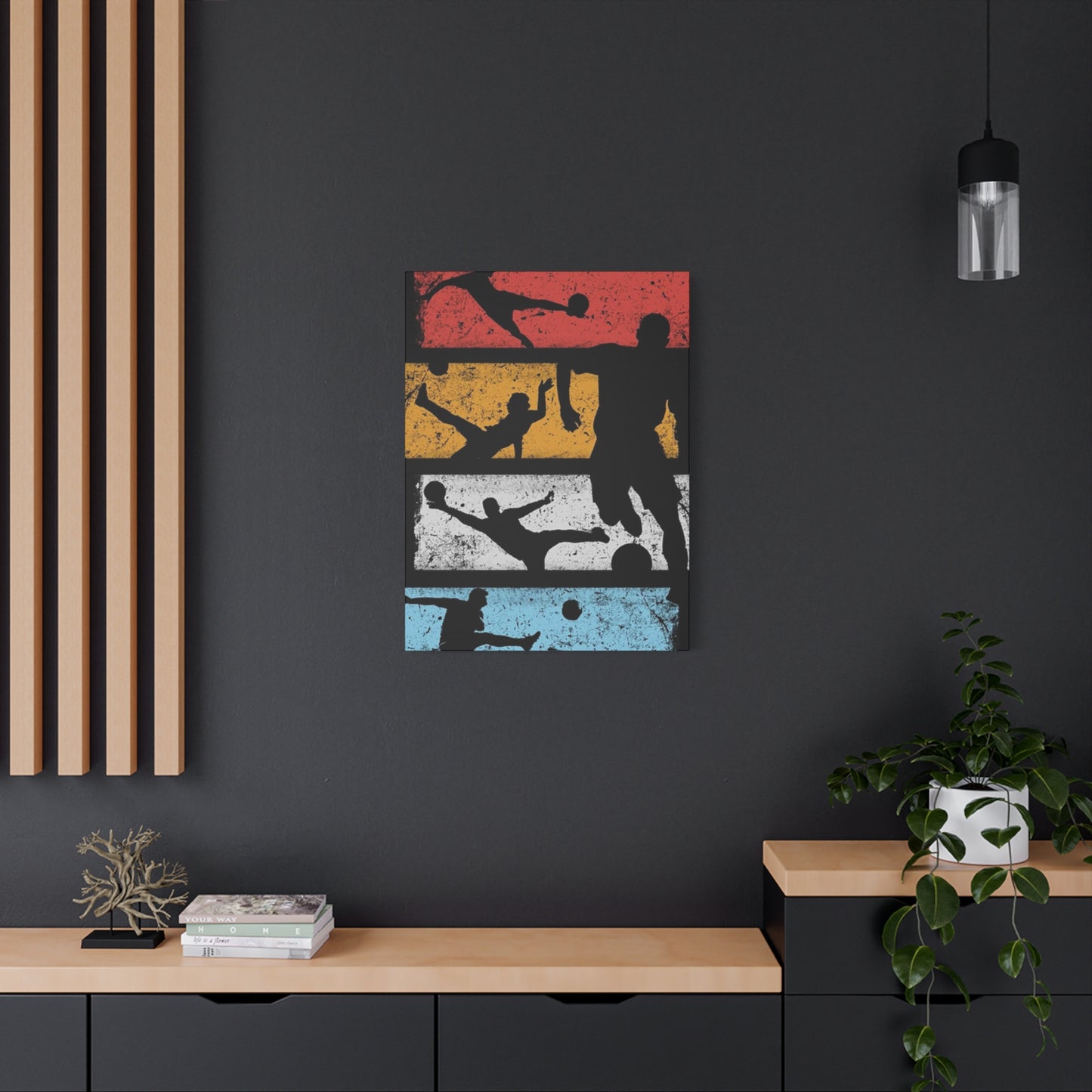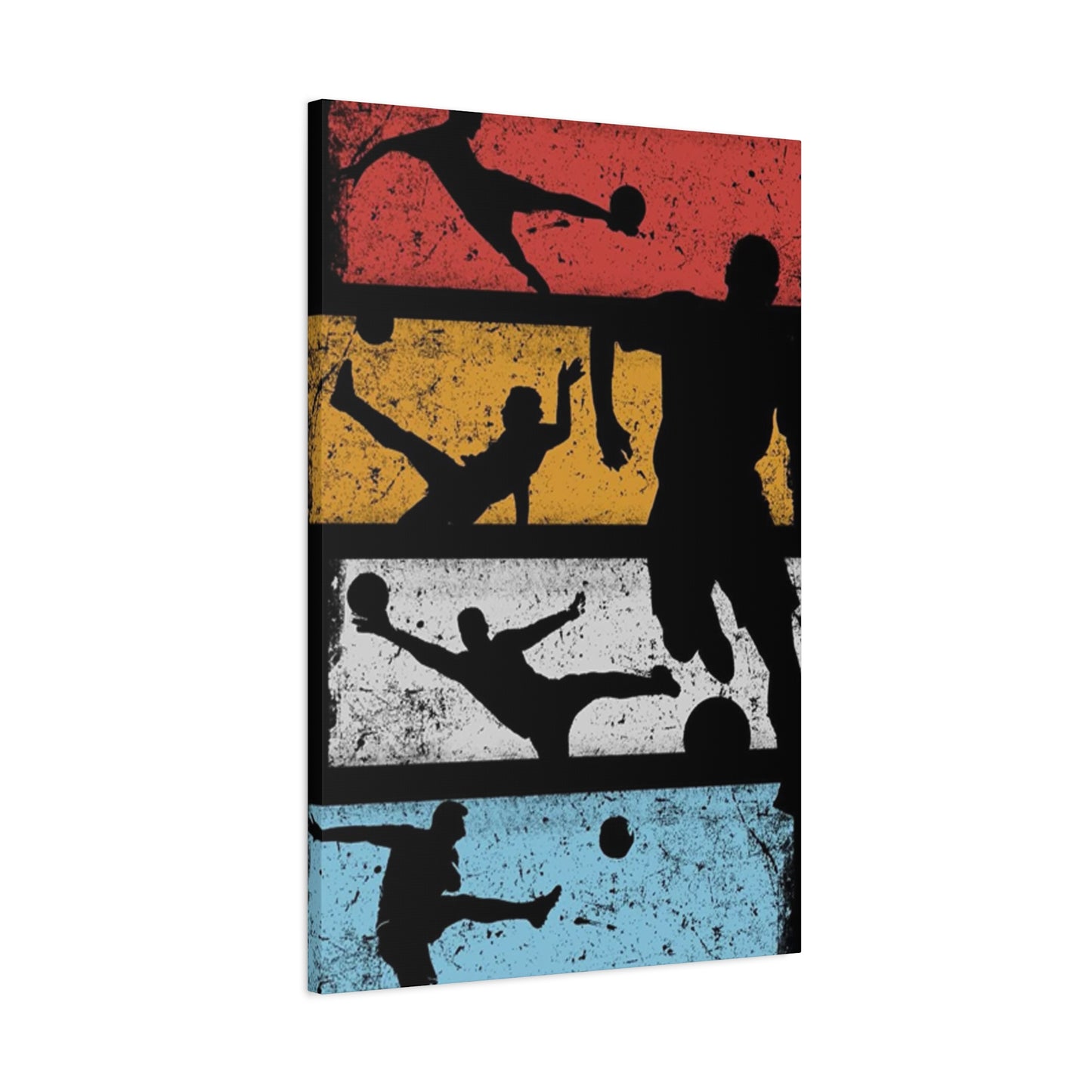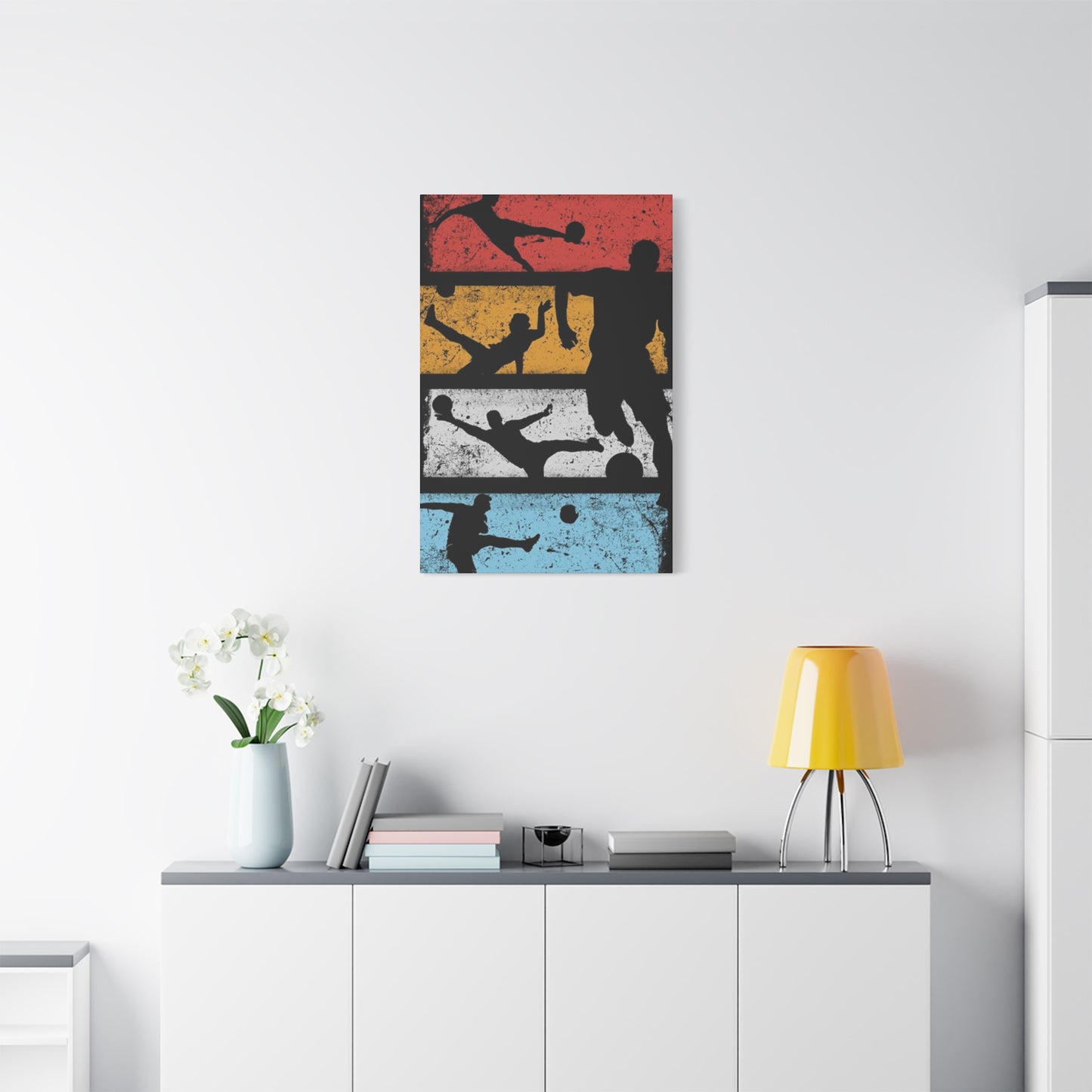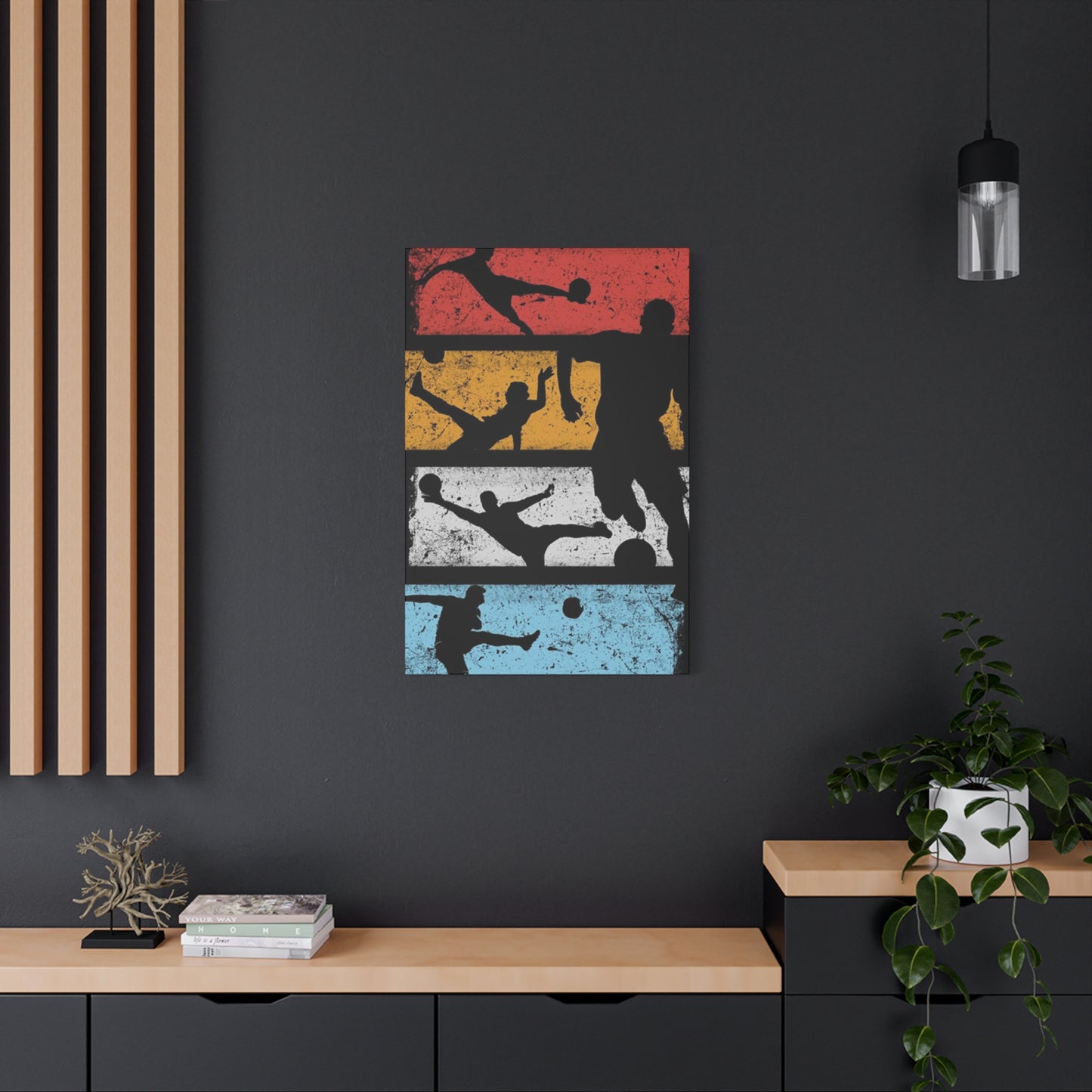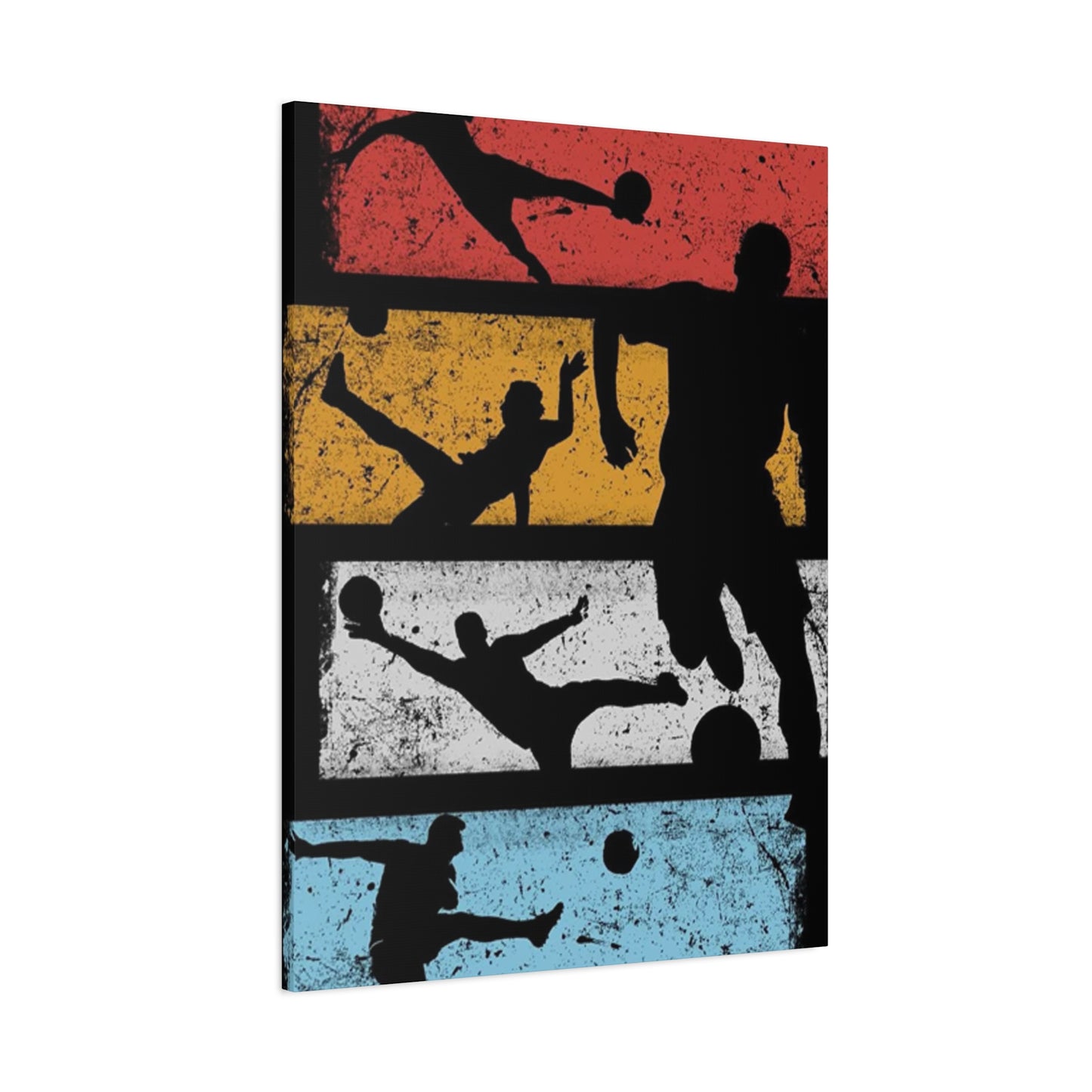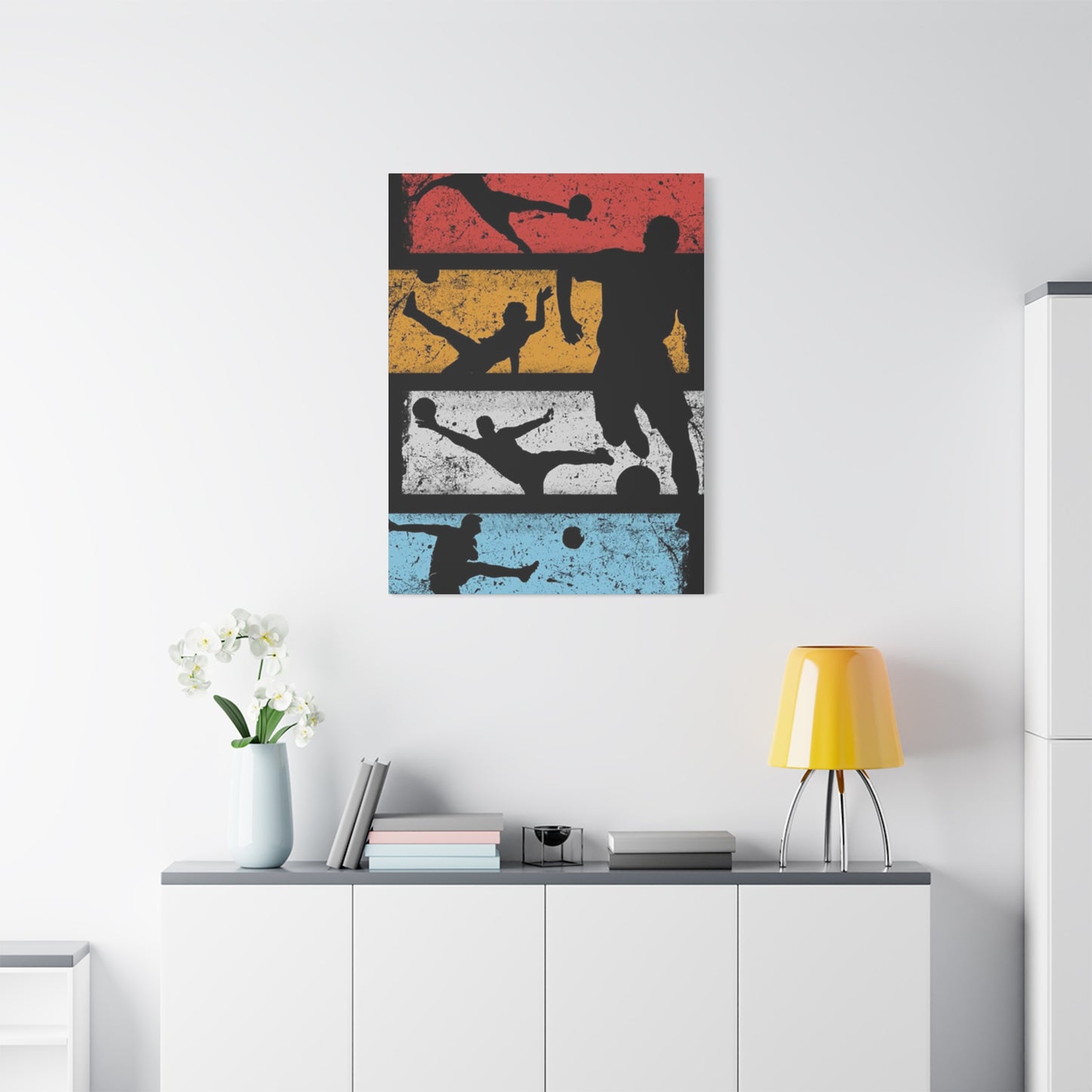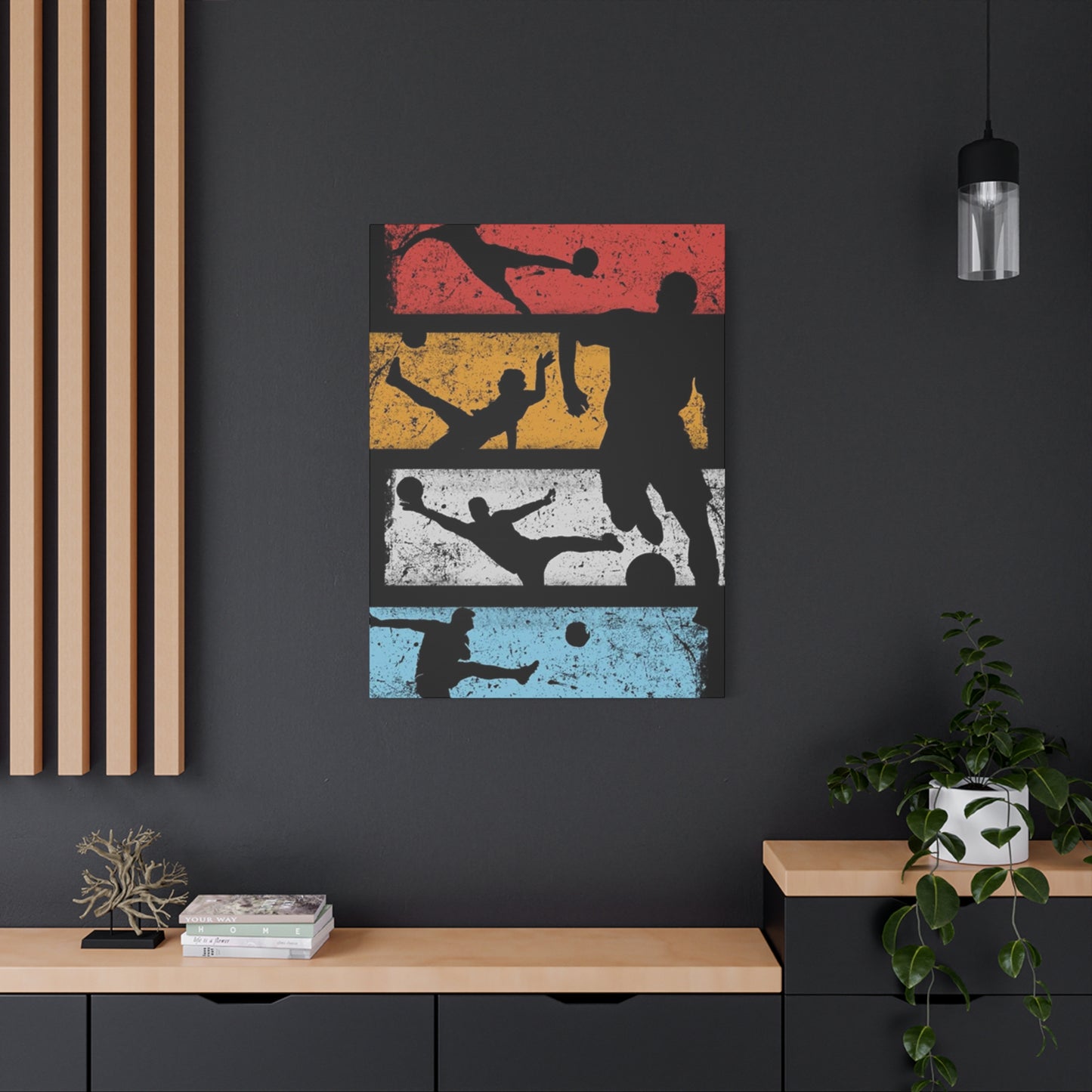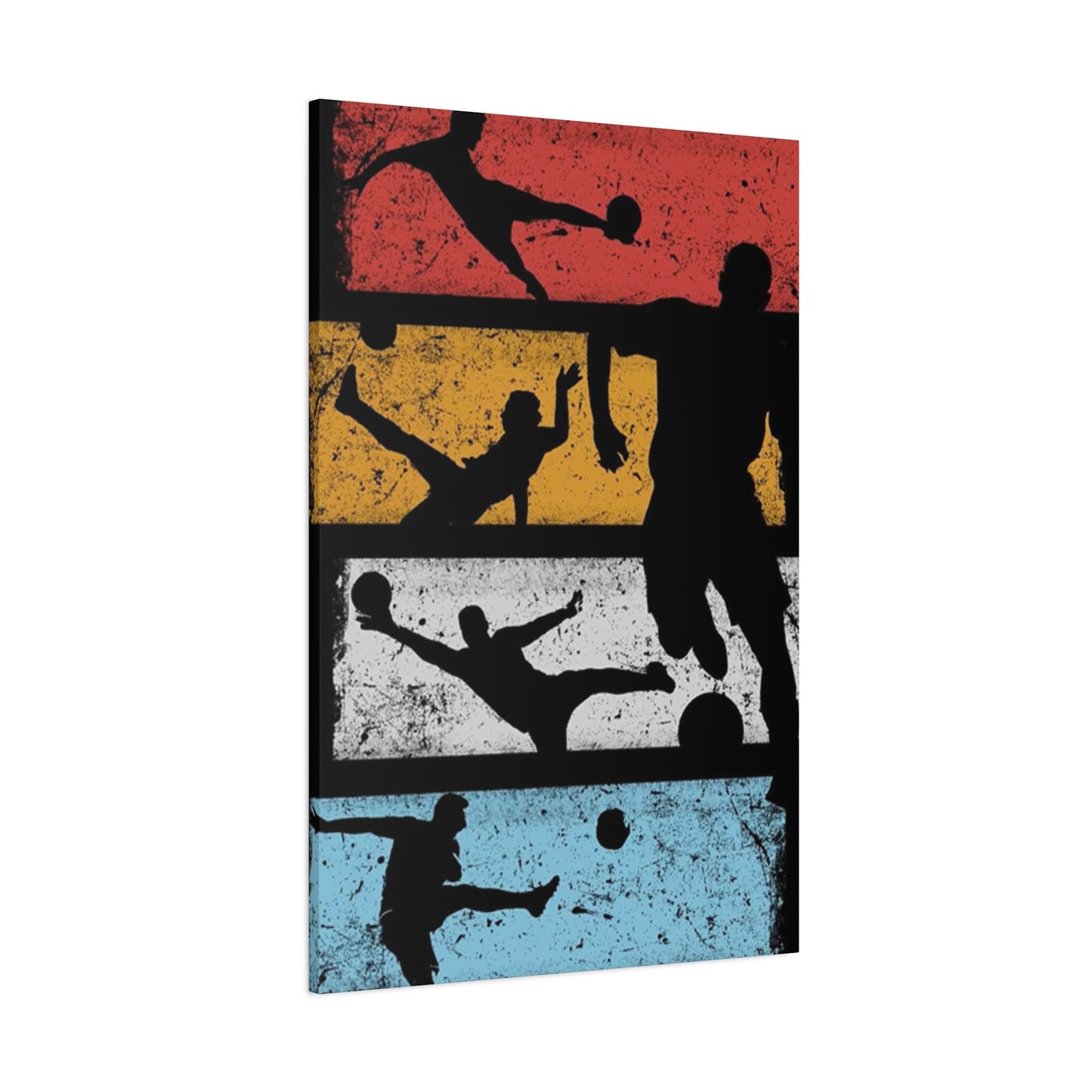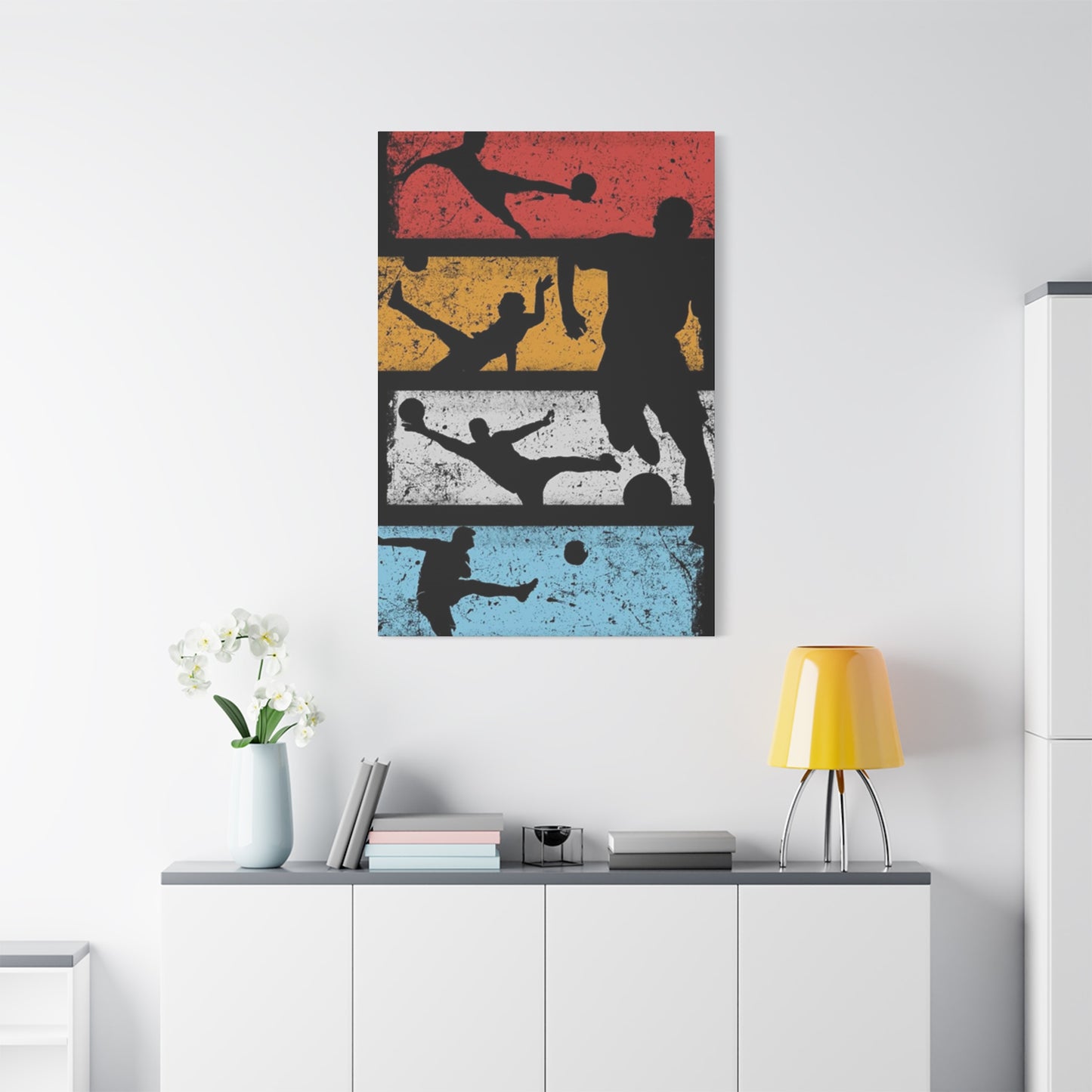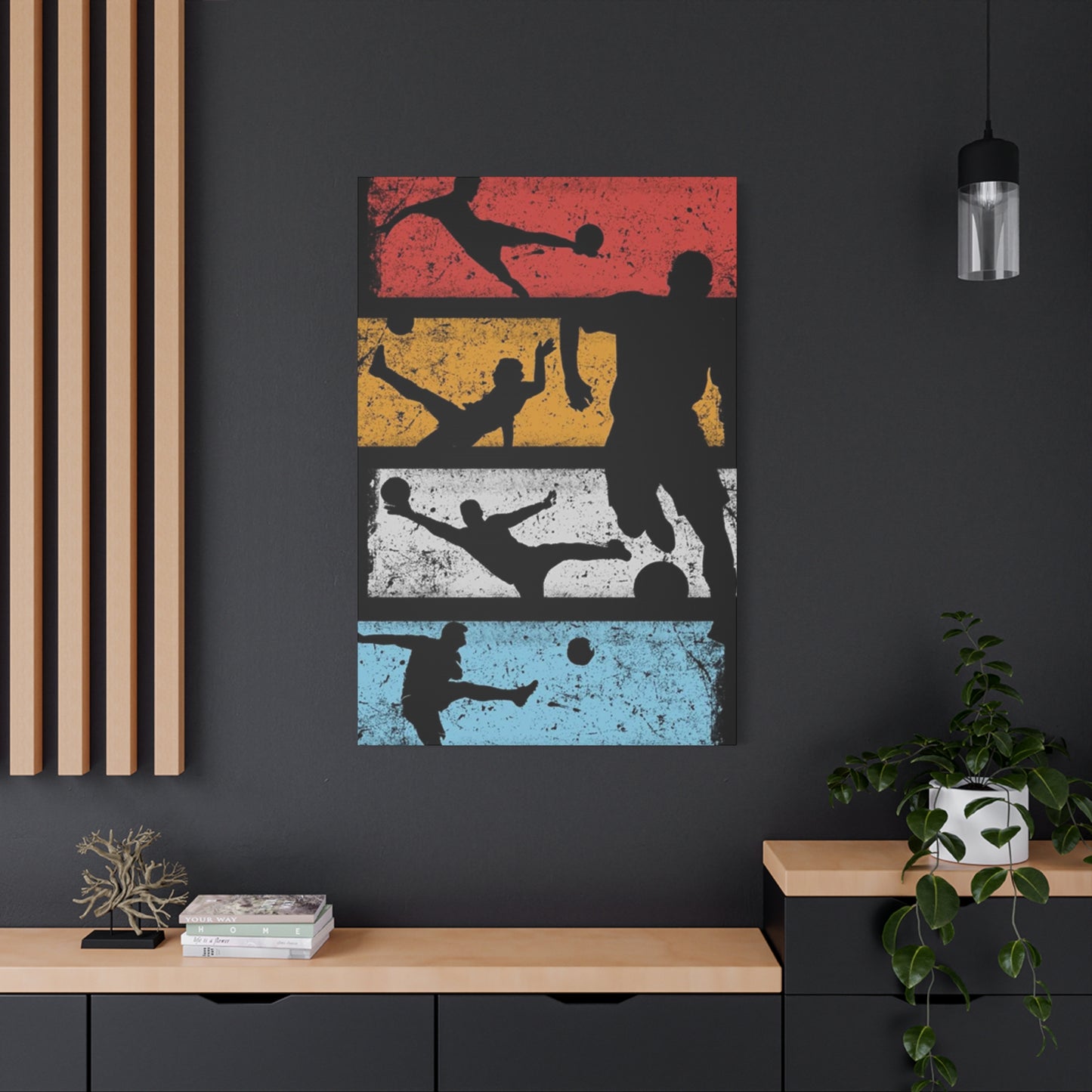Bold Silhouette Football Wall Art: Capturing Athletic Energy Through Shadow and Form
Football silhouette artwork represents a compelling fusion of athletic dynamism and artistic minimalism that has captured the imagination of sports enthusiasts and art collectors alike. This distinctive style strips away unnecessary details to focus on the pure essence of the game, showcasing players in motion through stark contrasts of light and shadow. The fundamental appeal lies in the ability to convey powerful emotion and movement using only the outline of a figure against a contrasting background.
The creation process typically begins with selecting iconic football poses that instantly communicate the sport's energy. Artists carefully study the biomechanics of players during crucial moments such as catching passes, making tackles, or celebrating touchdowns. The silhouette format demands precision because every curve and angle must contribute to the overall narrative without relying on facial expressions or detailed uniforms.
Traditional silhouette techniques originated centuries ago but have found new relevance in contemporary football artwork. Modern artists employ both digital tools and traditional mediums to create these striking pieces. Digital methods allow for precise editing and scaling, making it easier to reproduce artwork across various formats from small prints to massive stadium installations. Meanwhile, traditional techniques using cut paper, paint, or ink offer unique textures and authenticity that digital methods sometimes struggle to replicate.
Understanding composition is crucial when working with football silhouettes. The negative surrounding the figure becomes equally important as the figure itself, creating balance and directing the viewer's eye toward the action. Artists must consider how the figure interacts with edges and corners, ensuring the composition remains dynamic rather than static. Successful silhouette artwork often features figures positioned at angles that suggest movement beyond the frame, implying continuation of the action.
Color selection plays a vital role even in predominantly monochromatic pieces. While classic black-on-white remains popular, contemporary artists experiment with rich navy blues, deep burgundies, and forest greens that reference team identities without overwhelming the minimalist aesthetic. The background color influences the mood dramatically—bright whites suggest daytime energy and optimism, while darker backgrounds create dramatic, intense atmospheres perfect for highlighting championship moments.
Material choices significantly impact the final presentation of football silhouette artwork. Canvas remains the most popular substrate due to its texture and durability, providing a professional gallery-quality finish that elevates the artwork. Metal prints offer sleek, modern alternatives with incredible depth and vibrancy, while acrylic prints provide luminous quality with colors that seem to glow from within. Paper prints maintain traditional appeal and affordability, making silhouette artwork accessible to broader audiences.
The scale of silhouette artwork must be considered carefully based on intended display locations. Smaller pieces work beautifully in intimate settings like home offices or bedroom corners, while larger formats command attention in living areas or dedicated fan rooms. The simplicity of silhouette designs allows them to scale remarkably well without losing impact—a composition effective at poster size can be equally powerful when enlarged to mural dimensions.
Lighting considerations enhance silhouette football artwork dramatically. Strategic lighting creates additional depth and dimensionality, casting subtle shadows that amplify the three-dimensional illusion. Spotlights positioned at angles can create dramatic effects, while softer ambient lighting maintains visibility without creating glare on glossy surfaces. Some collectors install adjustable lighting systems allowing them to modify the mood based on time of day or occasion.
Understanding copyright and licensing remains essential when purchasing or creating football silhouette artwork. Original compositions based on generic athletic poses generally face no restrictions, but artwork depicting specific trademarked moments, recognizable players, or official team imagery requires proper authorization. Many artists navigate this by creating inspired pieces that capture the essence of memorable plays without directly copying protected photographs or footage.
The psychological impact of football silhouette artwork contributes significantly to its popularity among fans and athletes. These pieces serve as constant reminders of dedication, teamwork, and the pursuit of excellence. For young athletes, seeing silhouettes of players in peak performance positions can provide daily inspiration and reinforce commitment to training. For lifelong fans, these artworks connect them to cherished memories of legendary games and unforgettable seasons.
Simple Football Poses in Silhouettes
Capturing football action through simple poses requires understanding which positions most effectively communicate the sport's essence without requiring intricate detail. The quarterback throwing stance represents one of the most instantly recognizable football silhouettes, with the raised arm cocked back and body weight shifted forward suggesting imminent release. This pose conveys leadership, precision, and the strategic thinking that defines football at every level.
The receiver leaping for a catch creates another powerful silhouette opportunity, with arms extended upward and body fully elongated against gravity. This pose symbolizes aspiration, dedication, and the thrilling uncertainty of whether the catch will be completed. Artists often emphasize the arc of the body and the reaching quality of the hands, creating compositions that feel suspended in time at the peak moment of athletic achievement.
Running back poses showcase explosive power and determination, typically featuring players with forward lean, pumping arms, and driving legs. The silhouette should suggest unstoppable momentum, with every line contributing to the sense of forward motion. Many artists choose moments mid-stride where one leg propels while the other reaches forward, creating dynamic diagonal lines that energize the entire composition.
Defensive poses offer equally compelling silhouette opportunities, particularly the linebacker ready stance with bent knees, forward lean, and arms positioned for reaction. This coiled posture suggests potential energy about to be unleashed, creating tension that engages viewers. The silhouette format emphasizes the athletic readiness and mental preparation required for defensive excellence.
Kicking poses provide graceful alternatives to the more aggressive contact positions, showing players with one leg extended high while maintaining perfect balance. The arc described by the kicking leg creates beautiful curves within the composition, offering aesthetic variety when creating collections of multiple silhouette pieces. These poses celebrate the precision and technique required for successful field goals and punts.
Celebration poses capture the emotional release and joy that make football compelling beyond pure athleticism. Players with arms raised in victory, teammates embracing, or individuals pointing skyward after scoring create silhouettes filled with positive energy. These poses remind viewers that football encompasses not just physical competition but also human connection and shared achievement.
Lineman poses demonstrate the power positions that don't always receive visual attention in sports photography. Three-point stances with one hand planted and weight distributed across three points of contact create stable, grounded silhouettes that contrast beautifully with the more dynamic skill position poses. These compositions honor the essential but often overlooked players who make every play possible.
Coach silhouettes showing figures with clipboards, headsets, or gesturing during game situations add narrative variety to football artwork collections. These poses shift focus from physical performance to strategic thinking and leadership, acknowledging that football success requires intellectual preparation alongside athletic ability. Coach silhouettes work particularly well when paired with player action poses, creating visual storytelling opportunities.
Youth football poses offer touching alternatives that emphasize development, learning, and the pure joy of playing the game. Smaller figures in oversized equipment create charming silhouettes that appeal to parents, coaches, and anyone who appreciates the grassroots levels where football passion begins. These poses often feature slightly awkward positioning that authentically captures the learning process.
Historical football poses reference the evolution of the game, with players in vintage equipment or adopting techniques from earlier eras. Leather helmet silhouettes or single-bar facemask profiles create nostalgic pieces that appeal to football historians and older fans who remember different playing styles. These compositions celebrate the sport's heritage while maintaining contemporary artistic appeal.
Multiple-player silhouettes showing two or more athletes in coordinated action create more complex compositions that tell fuller stories. Quarterback-receiver connections, blocker-runner relationships, or defender-ball carrier confrontations add narrative depth. These multi-figure pieces require careful balance to ensure each silhouette remains distinct while contributing to unified composition.
Silhouettes showing equipment-focused poses highlight the tools that define football. A player holding a helmet at their side, clutching a football with determination, or adjusting gloves before entering the game creates intimate moments that connect viewers to pre-game rituals and preparation. These quieter poses provide contemplative alternatives to action-focused silhouettes.
Gender-inclusive football silhouettes acknowledge the growing participation of female athletes at all levels. Poses should convey identical athletic excellence and competitive spirit regardless of the player's gender, normalizing the presence of women in football artwork. These silhouettes help expand the sport's cultural representation and appeal to increasingly diverse audiences.
Adaptive football silhouettes represent athletes with physical disabilities competing at high levels, showcasing wheelchair football players or athletes with prosthetics. These powerful images challenge assumptions about athletic capability while celebrating the universal appeal of football competition. Such silhouettes make important statements about inclusion and the multifaceted nature of athletic excellence.
Weather-influenced poses show players battling elements like rain, snow, or intense heat, with body language adjusted to environmental conditions. Leaning into wind, shielding eyes from precipitation, or showing strain from temperature creates atmospheric silhouettes that acknowledge how conditions impact the game. These compositions add dramatic environmental storytelling to collections.
Practice silhouettes capture the less glamorous but equally important preparation that precedes game day success. Players running drills, performing conditioning exercises, or working on specific techniques create motivational artwork emphasizing dedication and work ethic. These poses inspire athletes by reminding them that excellence emerges from consistent effort rather than occasional brilliance.
Fantasy football-inspired silhouettes blend realistic athletic poses with imaginative elements like dramatic lighting effects, exaggerated proportions, or impossible physics. These creative interpretations appeal to fans who appreciate football's larger-than-life cultural presence and aren't bound to photorealistic representation. Such silhouettes bridge sports artwork and pop culture illustration.
Referee silhouettes add interesting perspective by showing officials signaling calls, measuring for first downs, or consulting with coaches. These figures represent the rules and structure that organize football chaos into coherent competition. Including official silhouettes in collections acknowledges the complete game ecosystem rather than focusing exclusively on players.
Mascot silhouettes offer playful alternatives that celebrate the pageantry and entertainment aspects surrounding football. These characters bring humor and school spirit to artwork collections, appealing particularly to younger fans and those who appreciate the community-building functions of football beyond pure competition.
Training equipment silhouettes show players interacting with sleds, tackling dummies, or agility equipment, emphasizing the specialized preparation required for football excellence. These compositions appeal to athletes and coaches who understand that performance results from properly applied training principles.
Combination poses showing players transitioning between positions or movements create dynamic silhouettes suggesting continuous motion rather than frozen moments. A quarterback dropping back to pass, a receiver cutting to change direction, or a defensive player pursuing at full speed captures the flowing nature of actual gameplay.
Minimalist Football Wall Decor
Minimalist approaches to football-themed decorating emphasize restraint, intentionality, and the power of suggestion rather than literal representation. This aesthetic philosophy strips away excess to focus on essential elements that effectively communicate football passion without overwhelming visual environments. The result creates sophisticated presentations that appeal to design-conscious fans who appreciate both sports and contemporary aesthetics.
The foundation of minimalist football decor begins with careful color palette selection. Rather than showcasing every team color simultaneously, minimalist approaches might feature a single accent color against neutral backgrounds. This could mean a single burnt orange accent in predominantly gray and white environments for Texas fans, or a solitary kelly green element for Eagles supporters. The discipline of limiting color creates sophisticated visual coherence.
Geometric interpretation of football elements offers another minimalist strategy. Simple line drawings suggesting football shapes, abstract representations of field markings, or geometric patterns inspired by stadium architecture provide football references without literal depiction. These subtle nods to the sport create layered meaning that rewards closer inspection while maintaining clean aesthetic lines from distance.
Negative utilization becomes crucial in minimalist football presentations. The empty surrounding silhouettes or graphic elements contributes equally to the overall design, creating breathing room that prevents visual overwhelm. Strategic negative allows the remaining elements to command attention through contrast and isolation rather than competing for visibility.
Typography-focused minimalist decor uses carefully selected words, phrases, or numbers to convey football passion. A single jersey number in elegant typeface, a favorite stadium name in architectural lettering, or a meaningful football quote in understated font creates powerful statements through text rather than imagery. The typeface selection becomes crucial, with clean sans-serif fonts typically supporting minimalist goals better than decorative alternatives.
Monochromatic schemes take minimalism to its logical conclusion by eliminating color variation entirely. Black-and-white football photography, grayscale silhouettes, or single-color graphic designs create dramatic impact through value contrast alone. This approach works particularly well in modern or industrial decorating schemes where color restraint maintains overall aesthetic consistency.
Scale manipulation within minimalist contexts means using either extremely small or dramatically large pieces rather than mid-sized alternatives. A tiny, perfectly framed football photograph on an otherwise empty wall creates intimate impact, while an oversized silhouette spanning an entire wall makes bold statements without requiring additional elements. Avoiding medium sizes prevents the "cluttered middle ground" that undermines minimalist goals.
Material honesty aligns well with minimalist philosophy in football decor. Displaying artwork on raw canvas without frames, mounting metal prints directly to walls without borders, or using floating shelf systems that minimize hardware visibility lets materials speak for themselves. This approach respects the inherent qualities of substrates rather than obscuring them with decorative additions.
Functional minimalism integrates football decor into practical objects rather than treating artwork as purely decorative. A minimalist clock featuring subtle field marking indicators, sleek shelving units with geometry inspired by stadium seating, or lighting fixtures incorporating football-shaped negative cutouts combine utility with fandom expression.
Strategic lighting becomes even more critical in minimalist presentations where fewer elements must carry greater impact. Precise spotlighting can transform a simple silhouette into a focal point that anchors entire rooms. Track lighting systems offer flexibility to adjust emphasis as needed, while integrated LED strips can provide subtle accent lighting that enhances without dominating.
Texture introduction adds depth to minimalist football decor without requiring additional visual elements. A silhouette printed on linen creates different impact than the same image on smooth metal. Rough concrete surfaces, brushed aluminum finishes, or deliberately distressed wood introduce tactile interest that engages senses beyond vision.
Asymmetric placement challenges traditional centering conventions in ways that energize minimalist presentations. Positioning a football silhouette in an upper corner rather than centered on a wall creates dynamic tension and suggests movement beyond the frame. This approach requires confidence but yields sophisticated results that elevate simple elements.
Series consistency matters tremendously when creating minimalist collections. If displaying multiple pieces, maintaining identical sizes, matching frames, consistent matting, and unified color palettes prevents the collection from feeling haphazard. The repetition and rhythm created by consistent elements becomes a design feature itself.
Breathing room between displayed pieces remains essential in minimalist contexts. Overcrowding undermines the entire aesthetic philosophy by creating visual competition. Generous separation between pieces—often significantly more than feels initially comfortable—allows each element to exist independently while contributing to the overall environment.
Furniture integration rather than wall-only focus expands minimalist football decor possibilities. A coffee table featuring a subtle football field diagram etched into glass, throw pillows with simple geometric football patterns, or a minimalist area rug incorporating yard line references distributes football theming throughout rooms without creating overwhelming focal walls.
Quality over quantity becomes the guiding principle for minimalist football collections. A single museum-quality piece commands more respect than dozens of lower-quality alternatives. This approach requires patience and potentially larger single investments but creates environments that feel curated rather than accumulated.
Symbolic representation allows minimalist decor to reference football without literal depiction. The number forty-two might reference a favorite player or significant yardage, creating personal meaning that isn't immediately obvious to casual observers. This creates layered environments where football fans recognize significance while the broader aesthetic remains accessible.
Modular systems offer flexibility within minimalist frameworks. Magnetic mounting systems, grid-based hanging solutions, or flexible track systems allow rearranging or rotating displayed pieces without permanent wall damage. This adaptability lets collections evolve while maintaining minimalist principles.
Transparency and translucency add ethereal qualities to minimalist football decor. Silhouettes printed on acrylic panels, etched glass featuring simple football imagery, or sheer curtains with subtle pattern details create ghostly presences that suggest rather than declare football passion.
Architectural integration treats football decor as environmental elements rather than added decorations. Built-in alcoves designed to display specific pieces, recessed lighting engineered around artwork dimensions, or permanent installations that become architectural features represent the pinnacle of minimalist integration.
Digital displays offer ultimate flexibility for minimalist football enthusiasts who want to rotate imagery regularly. High-quality digital frames can showcase different silhouettes, change team colors based on schedules, or feature photography collections without requiring physical replacement. When framed properly and set to appropriate brightness, digital displays integrate seamlessly into minimalist environments.
Using Silhouettes to Show Football Action
Translating three-dimensional athletic movement into two-dimensional silhouette form requires sophisticated understanding of motion, timing, and visual storytelling. The challenge lies in selecting precise moments within continuous action that encapsulate entire plays while remaining instantly comprehensible. Successful action silhouettes freeze time at peak instants when body positions most clearly communicate athletic intention and explosive power.
Dynamic poses revealing directional movement employ several visual techniques to overcome the static nature of silhouette artwork. Artists incorporate motion blur effects around extremities like hands and feet, suggesting movement too fast to capture crisply. Trailing elements showing multiple positions of limbs in slightly different locations create the illusion of sequential motion within single frames. These techniques borrowed from comic book illustration translate effectively to silhouette format.
Anticipated action presents another powerful approach where the silhouette captures the instant before movement releases. A defensive player coiled just before launching toward a ball carrier, a receiver with eyes tracking an approaching pass, or a kicker in the final moment before foot contacts football creates dramatic tension. Viewers mentally complete the action themselves, engaging more actively with artwork by imagining the immediate aftermath.
Follow-through moments showing players after completing actions offer alternatives to peak-instant captures. A quarterback with arm fully extended after releasing a pass, a kicker maintaining balance after follow-through, or a linebacker rising after making a tackle tells complete stories through the residual energy visible in body positioning. These poses emphasize completion and consequence rather than explosive initiation.
Multiple-frame sequences displayed as series create narrative progression impossible in single silhouettes. A three-panel arrangement might show a receiver approaching, leaping for, and securing a catch. Five-panel sequences can document entire plays from snap to completion. These collections work particularly well in horizontal arrangements along hallway walls or above lengthy furniture pieces.
Collision moments capturing contact between players create intensely dramatic silhouettes, though they require careful composition to remain visually comprehensible. Overlapping figures can become confused masses unless artists carefully plan which elements appear in front and which recede. Strategic gaps between figures even during contact help maintain visual clarity while preserving the impact of athletic collision.
Velocity indicators through compositional techniques help static silhouettes suggest speed. Horizontal arrangements with figures leaning forward suggest rapid movement across the field. Diagonal compositions with players angled suggest explosive directional changes. Background elements like stretched yard lines or motion-blurred crowds provide environmental context that reinforces speed perception.
Aerial perspective silhouettes showing overhead views of plays in progress offer unique alternatives to side-view compositions. These bird's-eye perspectives reveal formation patterns, strategic positioning, and field relationships impossible to capture from ground level. While less common, aerial silhouettes appeal to tactically-minded fans who appreciate strategic rather than purely physical aspects of football.
Emotional action extends beyond physical movement to capture psychological states during competition. Silhouettes showing frustrated players after missed opportunities, jubilant teammates celebrating scores, or exhausted athletes during timeouts communicate the emotional roller coaster that makes football compelling. These quieter action moments provide valuable counterpoints to explosive physical plays.
Equipment interaction silhouettes showing players making dramatic catches, fighting for fumbles, or stretching toward goal lines with footballs clearly visible create object-focused compositions. The football itself becomes a crucial compositional element, with its distinctive shape instantly recognizable even in silhouette form. Artists often slightly exaggerate football size to ensure visibility.
Environmental integration places athletic action within contextual settings. Silhouettes positioned against suggestion of goalposts, yard markers, or stadium elements ground the action geographically and add narrative layers. Background treatments can range from minimal suggestions to detailed renderings, depending on whether minimalist or illustrative approaches better serve the composition.
Physics-defying action embraces creative liberty to show athleticism exceeding normal human capability. Players suspended impossibly high above ground, moving at exaggerated speeds, or displaying superhero-like qualities appeal to fans who appreciate football's mythological dimensions. These fantastical silhouettes work particularly well for championship celebrations or legendary player tributes.
Weather-influenced movement shows how environmental conditions modify athletic technique. Players adjusting running styles for muddy fields, receivers securing catches in driving rain, or snow obscuring portions of silhouettes adds atmospheric drama. These environmental elements create seasons-specific artwork that acknowledges the variety of conditions under which football occurs.
Close-up action focuses on specific body parts during crucial moments—hands cradling footballs, feet planting before cuts, or faces behind facemasks showing determination. While moving away from full-body silhouettes, these intimate details provide variety within collections and emphasize the specialized techniques required for position-specific excellence.
Team coordination silhouettes show multiple players executing synchronized actions like offensive line blocking schemes, secondary defensive coverages, or special teams units. These collaborative compositions celebrate teamwork and coordination, appealing to fans who appreciate how eleven players must function as single organisms for successful plays.
Historical action recreates legendary plays from football history through silhouette interpretation. While avoiding direct copying of protected images, artists can recreate famous moments like immaculate receptions, goal-line stands, or championship-winning catches in silhouette form that honors without infringing. These pieces appeal to fans who treasure football heritage.
Training action silhouettes document the practice and preparation underlying game performance. Players running agility drills, executing proper tackling technique, or performing strength exercises create motivational artwork emphasizing that visible game action results from invisible preparation. These pieces resonate particularly with athletes and coaches.
Signature moves associated with specific positions or players can be abstracted into recognizable silhouettes. A quarterback's distinctive throwing motion, a receiver's characteristic route-running style, or a defender's unique celebration creates personalized artwork without requiring facial recognition or jersey numbers.
Slow-motion interpretation suggests the stretched-time perspective available through video replay. Exaggerated body positions showing maximum extension, faces frozen mid-expression, or equipment captured at angles impossible in real-time creates surreal quality that emphasizes extraordinary moments deserving extended contemplation.
Abstract motion dissolves realistic representation into pure movement energy, showing streaks of color, geometric shapes suggesting players, or completely non-representational compositions that evoke football action without depicting it. These avant-garde approaches appeal to collectors seeking art-first pieces that reference rather than illustrate the sport.
Small Football Silhouette Canvas Ideas
Compact canvas formats offer distinct advantages for football silhouette presentations, particularly regarding versatility, affordability, and display flexibility. Small-scale pieces measuring eight by ten inches or smaller create opportunities for personal collections, gift-giving, and arrangements impossible with larger formats. These intimate sizes invite closer inspection and allow for displaying multiple related pieces without overwhelming available wall dimensions.
Gallery wall arrangements consisting entirely of small football silhouette canvases create impactful presentations through cumulative effect rather than individual monumentality. Twelve to twenty small canvases arranged in grid patterns, asymmetric clusters, or flowing curves tells comprehensive football stories through episodic visual narrative. Each canvas might represent different positions, famous plays, or sequential game moments, with the complete arrangement functioning as unified artwork.
Position-specific collections using small canvases allow fans to celebrate every role contributing to football success. A quarterback canvas paired with receiver, running back, offensive lineman, and other position silhouettes creates complete offensive unit representations. Defensive collections might include linemen, linebackers, and defensive backs. Special teams units complete the roster, acknowledging every player's contribution regardless of visibility.
Seasonal progression series documents football's annual cycle through small canvases showing training camp activities, preseason preparation, regular season intensity, playoff desperation, and championship glory. This storytelling approach creates year-round relevance rather than limiting artwork to fall football seasons. Fans can rotate displayed pieces to match current calendar periods.
Personal achievement documentation through small custom silhouette canvases celebrates individual athletic accomplishments. Parents commission pieces showing children making first touchdowns, coaches create recognition gifts featuring players mastering techniques, or adult recreational players commemorate league championships. These personalized small canvases become cherished keepsakes marking football milestones.
Desk and shelf displays make small canvases practical for office environments or personal workspace decorating. A six-inch canvas positioned on desktop easels or leaned against books on shelves brings football inspiration to work environments without requiring wall mounting or appearing unprofessional. These portable pieces travel easily when changing workspaces.
Layered easel presentations arrange multiple small canvases at varying depths on shelving units or mantels. Front pieces partially obscure those behind, creating dimensional displays that viewers must approach from different angles to see completely. This arrangement technique adds interactive elements as observers move around to discover previously hidden canvases.
Jersey number collections using small canvases feature silhouettes incorporating significant numbers—childhood jersey assignments, professional player tributes, or lucky numbers with personal meaning. Each canvas shows a silhouette with its associated number prominently incorporated. These collections work beautifully for families with multiple athletes or fans celebrating favorite players across generations.
Color accent systems use small canvases to introduce team colors into neutral decorating schemes. Three or four small canvases in team colors create sufficient presence to declare fan loyalty without dominating the entire room palette. This balanced approach maintains domestic harmony when household members support different teams or prefer subtle rather than overwhelming team representation.
Window ledge displays take advantage of horizontal surfaces often left bare. Small canvases leaned against windows with natural backlighting create shadow effects that enhance silhouette drama. This display method requires no wall damage while utilizing otherwise wasted vertical surfaces. Arrangements can change seasonally or match game schedules.
Travel collections document football experiences across different venues. Small canvases featuring silhouettes associated with particular stadiums, memorable games attended, or cities visited during football trips creates geographic football journals. These pieces trigger specific memories while celebrating broader football passion.
Budget-conscious collecting becomes feasible with small canvas formats that cost significantly less than larger alternatives. New collectors or younger fans can build meaningful collections gradually, adding pieces to commemorate each season, championship, or significant game. The lower price point makes football artwork accessible to broader audiences.
Gift set arrangements package multiple small coordinated canvases as complete presentations. A boxed set of four position-specific silhouettes or six sequential action poses creates ready-to-display collections perfect for birthdays, holidays, or recognition occasions. Recipients appreciate the thoughtful curation that creates instant collections rather than requiring years of accumulation.
Bathroom and unusual location displays bring football passion to unexpected contexts. Small canvases work appropriately in bathrooms, laundry rooms, or home gyms where larger pieces might seem excessive. This distribution throughout homes creates comprehensive environments rather than limiting football references to designated fan rooms.
Nightstand and bedroom applications provide inspiration immediately upon waking and before sleeping. Small canvases on bedroom walls or nightstand surfaces create personal sanctuaries celebrating football dedication. For young athletes, these pieces provide daily reminders of goals and commitments.
Locker and training facility decorating uses small canvases in communal athlete environments. Coaches install position-specific silhouettes above corresponding locker assignments, creating personalized while reinforcing player identity and responsibility. Training facilities use small canvases to mark different drill stations or technique focus areas.
Vehicle displays bring football passion to cars, trucks, or recreational vehicles. Magnetic-backed small canvases attach to metal surfaces, dashboard easels hold miniature pieces, or sun visors feature mounted silhouettes. These mobile displays travel with fans to tailgates and away games.
Hostess and thank-you gifts provide memorable alternatives to generic wine bottles or flowers. Small custom silhouettes acknowledging shared team loyalty or referencing specific games create personal tokens demonstrating thoughtfulness and effort beyond generic gifts.
Photographic incorporation involves displaying small football silhouette canvases alongside actual photographs in mixed-media arrangements. The contrast between photographic realism and artistic abstraction creates visual interest while maintaining thematic unity. This approach works well for memory walls combining documented moments with artistic interpretation.
Calendar integration uses twelve small canvases to mark months in functional calendar displays. Each canvas represents that month's football significance—August training camps, September season openers, October rivalry games, November playoff races, December championships, and off-season months showing preparation activities.
Large Football Silhouette Prints
Monumental football silhouette prints measuring four feet or larger create commanding presences that transform entire environments into tributes to athletic excellence. These substantial pieces function as architectural elements rather than mere decorations, anchoring rooms and establishing dominant visual themes. The psychological impact of large-scale silhouettes dramatically exceeds that of smaller alternatives, creating immersive experiences that surround viewers with football energy.
Statement wall applications dedicate entire surfaces to single massive silhouettes, eliminating competing visual elements and forcing focus toward the featured image. A wall-to-wall silhouette of a player mid-leap or driving toward the end zone creates rooms where football passion becomes environmental rather than decorative. This approach works particularly well in dedicated fan rooms, home theaters, or recreational areas where thematic consistency matters more than aesthetic versatility.
Material considerations become especially important at large scales where substrate choices significantly impact both appearance and budget. Canvas prints at large dimensions require gallery-wrap mounting to maintain tautness and prevent sagging. Metal prints offer spectacular clarity and durability but require professional installation due to substantial weight. Vinyl wall decals provide affordable large-scale options with the advantage of removability, though they lack the permanence and gravitas of mounted prints.
Installation challenges increase proportionally with size, requiring careful planning and often professional assistance. Large canvases need multiple hanging points to distribute weight safely, with calculations considering both print and frame weight if applicable. Wall studs must be located precisely, and appropriate hardware selected for load capacity. Improper installation risks damage to both artwork and walls, making professional hanging services worthwhile for premium pieces.
Viewing distance calculations help determine appropriate sizes for specific locations. General guidelines suggest standing back from large prints at distances equal to roughly one and a half times the print's diagonal measurement for optimal viewing. This ensures compositions remain comprehensible rather than becoming abstract masses of color when viewed too closely. Room dimensions must accommodate these viewing distances for large prints to achieve intended impacts.
Vertical versus horizontal orientation decisions affect how large silhouettes interact with architectural features. Tall vertical prints emphasize ceiling height and work well in narrow wall sections between windows or doorways. Horizontal formats suit long walls above furniture or in hallways. Square formats offer balanced alternatives that work in various architectural contexts without forcing specific orientations.
Multi-panel large installations create even more dramatic impacts by spreading single compositions across multiple connected canvases. A quarterback throwing motion might span three vertical panels, a receiver's leap might spread across four sections, or an entire play's progression might extend across five connected pieces. These installations allow for truly massive scales while maintaining portability and manageable individual canvas sizes.
Outdoor durability becomes relevant for large prints displayed in covered patios, pool house areas, or garage environments. Weather-resistant materials like marine-grade metal prints or UV-protected canvas withstand temperature fluctuations and humidity better than standard alternatives. Proper sealing and mounting protect large investments from environmental degradation.
Lighting design specifically engineered for large prints ensures proper visibility and dramatic presentation. Picture lights mounted above frames provide focused illumination, while track lighting systems allow angle adjustments. Some collectors install LED strips behind large canvases creating halo effects that make silhouettes appear to float away from walls. Proper lighting transforms large prints from mere decorations into genuine focal features.
Curved wall applications adapt large prints to architectural features like barrel ceilings or rounded alcoves. Flexible substrate materials or custom mounting solutions conform to curved surfaces, creating integrated installations that acknowledge and enhance existing architecture rather than fighting against it. These applications require expert installation but yield spectacular results.
Commercial applications extend large football silhouettes beyond residential contexts into restaurants, sports bars, training facilities, and corporate environments. Businesses leverage large-scale imagery to establish atmospheric branding and create memorable environments. These installations often involve even larger dimensions than residential applications, with some commercial silhouettes exceeding ten feet in height.
Temporary event installations use large prints to transform venues for football-themed parties, banquets, or corporate gatherings. Lightweight substrates on portable mounting systems allow quick installation and removal without permanent wall modifications. These applications prioritize impact over longevity, using affordable materials that need only survive single events.
Projection alternatives offer flexible large-scale solutions without permanent installations. High-lumen projectors display football silhouettes at truly massive sizes on blank walls, with the ability to change images instantly or rotate through collections. While lacking the permanence and always-available presence of physical prints, projection systems offer unmatched flexibility for multi-purpose environments.
Museum-quality large prints employ archival materials and professional framing techniques ensuring decades-long preservation. These premium presentations use acid-free materials, UV-protective glazing, and conservation mounting methods that prevent deterioration. While significantly more expensive than standard options, museum-quality treatments protect valuable artwork and maintain resale value.
Custom sizing accommodates unusual architectural dimensions like extra-tall ceilings, awkwardly proportioned walls, or specific furniture relationships. Rather than accepting standard dimensions, custom large prints maximize available territories while maintaining proper compositional balance. This bespoke approach ensures perfect integration with existing environments.
Interactive large prints incorporating augmented reality features allow smartphone apps to trigger additional content when pointed at physical artwork. Viewers might see the full color version of silhouettes, watch video of the depicted play, or access player statistics. These technological integrations create hybrid experiences bridging physical and digital realms.
Heritage large prints reproduce historical football photography as silhouettes, creating nostalgic tributes to earlier eras. Vintage game scenes, legendary player poses, or historic stadium imagery transformed into large-scale silhouettes honor football's evolution while maintaining contemporary artistic sensibilities.
Championship celebration large prints commemorate significant victories through massive silhouettes of triumphant moments. These pieces mark specific achievements rather than generic football appreciation, creating permanent tributes to unforgettable seasons. Teams often commission such pieces for facility installations honoring championship teams.
Practice facility motivational installations use large silhouettes displaying perfect technique to provide constant visual references for athletes in training. These educational applications serve dual purposes as both decoration and instructional aids, reinforcing proper form through repeated visual exposure.
Fundraising auction pieces leverage large-scale silhouettes as premium donation items for booster clubs, athletic department events, or charitable causes. The substantial physical presence justifies higher bidding, while customization options create unique items unavailable through retail channels.
Caring for Silhouette Football Art
Proper maintenance extends the lifespan and preserves the visual impact of football silhouette artwork across all formats and materials. Different substrates require specific care approaches, with universal principles emphasizing gentle handling, appropriate environmental conditions, and preventive measures rather than reactive repairs. Understanding material-specific vulnerabilities helps collectors make informed decisions about display locations and handling procedures.
Canvas care begins with regular dusting using soft, lint-free cloths or specialized art dusters. Feather dusters should be avoided as they can scratch canvas surfaces or leave residue. Light, gentle strokes following the canvas weave direction prevent pushing dust into textured surfaces. For canvas prints with heavy texture or impasto effects, very soft brushes designed for artwork cleaning work better than cloths.
Humidity control protects canvas from warping, mold growth, and deterioration. Ideal relative humidity ranges between forty and fifty-five percent, with consistency mattering more than achieving perfect numbers. Sudden humidity changes cause canvas expansion and contraction that can damage prints or stretch them loose from frames. Dehumidifiers in damp climates and humidifiers in arid environments maintain appropriate conditions.
Temperature regulation prevents thermal stress to artwork materials. Extreme heat causes canvas loosening, adhesive failure in mounted prints, and accelerated fading of pigments. Cold temperatures can make materials brittle and susceptible to cracking. Maintaining consistent temperatures between sixty-five and seventy-five degrees Fahrenheit provides safe conditions for most football artwork.
Direct sunlight represents perhaps the greatest threat to silhouette artwork longevity. Ultraviolet radiation causes irreversible fading, discoloration, and material degradation. Even indirect natural light contains enough UV radiation to damage artwork over time. Positioning prints away from windows or installing UV-filtering window films protects collections. For artwork receiving natural light, UV-protective glazing or acrylic covers provide additional defense.
Artificial lighting choices affect both visibility and preservation. Incandescent bulbs generate significant heat that can damage nearby artwork over time. LED lighting provides excellent visibility while generating minimal heat and containing negligible UV radiation. When installing picture lights or track lighting, maintaining appropriate distances prevents heat accumulation near artwork surfaces.
Conclusion:
In conclusion, bold silhouette football wall art offers a powerful and dynamic way to celebrate the spirit, energy, and athleticism of the game through the elegant simplicity of shadow and form. By focusing on the essence of movement rather than intricate detail, this art style captures the raw intensity and fluidity of football, transforming walls into vibrant arenas of passion and action. For sports enthusiasts, athletes, or anyone inspired by the vigor of the game, silhouette football art is a compelling way to bring that energy into everyday spaces.
What makes silhouette football art particularly striking is its ability to convey emotion and motion with minimalistic design. The sharp contrast between dark figures and light backgrounds emphasizes athletic form, posture, and gesture, distilling complex plays and moments into instantly recognizable and impactful visuals. This style celebrates not only the physicality of football but also the dedication, focus, and teamwork that define the sport. Whether it’s a quarterback in mid-throw, a receiver leaping for a catch, or a defensive lineman in pursuit, these silhouettes evoke the heart-pounding drama of the game with elegant clarity.
Bold silhouette football art also excels in its versatility. Its clean lines and strong contrasts make it suitable for a variety of interior styles—from modern and industrial lofts to sports-themed rooms and casual living areas. The simplicity of the artwork allows it to complement existing décor without overwhelming, while still commanding attention as a focal point. This makes it an ideal choice for game rooms, home gyms, offices, or even public sports venues seeking to inspire and energize.
Moreover, the monochromatic nature of silhouette art provides flexibility in color schemes. While classic black-and-white pieces deliver timeless appeal, incorporating team colors or customized palettes can personalize the art and deepen its emotional connection for fans and players alike. This customization enhances the sense of identity and pride associated with football culture.
The emotional impact of bold silhouette football wall art goes beyond aesthetics. It captures the drive, resilience, and competitive spirit that resonate with athletes and admirers, making it a source of motivation and inspiration. Displaying such art is a celebration of sport’s ability to unite, challenge, and uplift.
Ultimately, bold silhouette football wall art is a timeless tribute to the power and grace of athletic performance. By integrating these visually arresting pieces into your space, you invite the excitement and intensity of football into daily life, creating an environment charged with energy, passion, and inspiration.

















